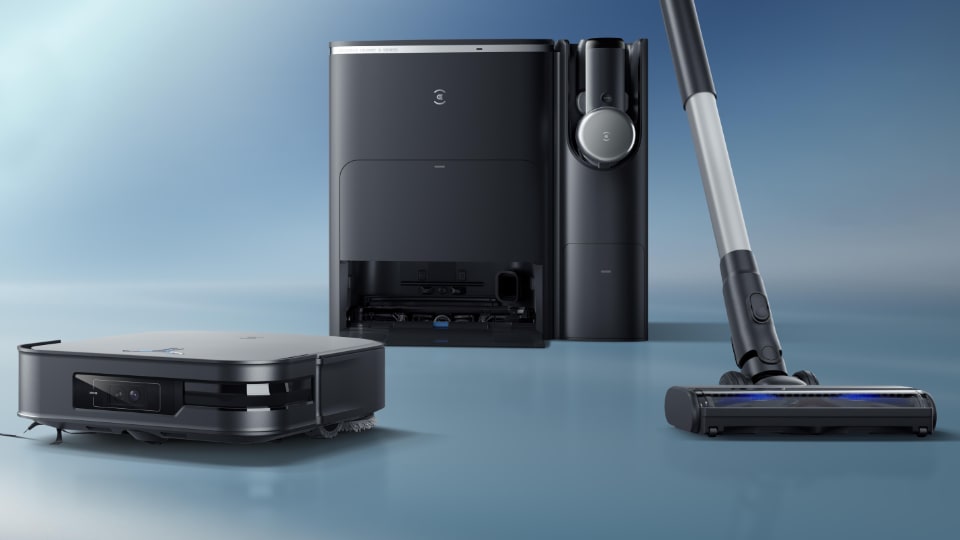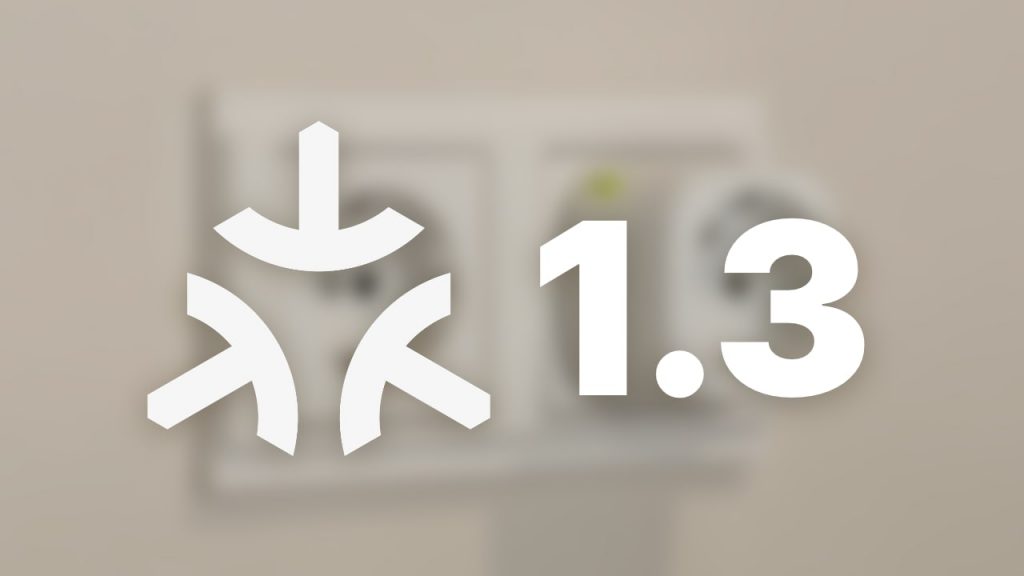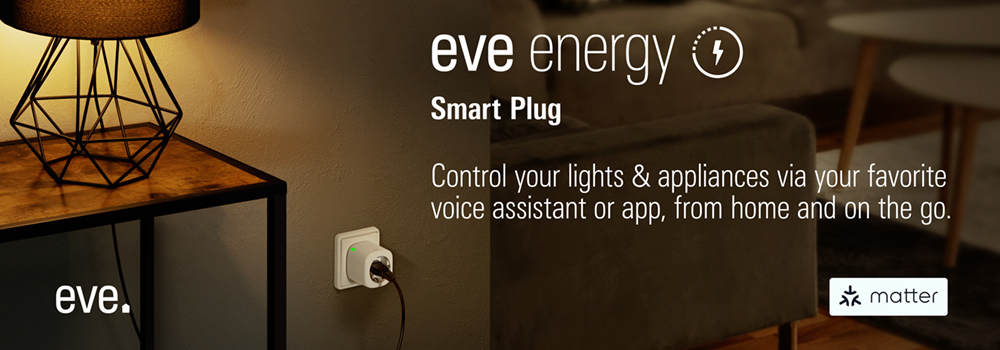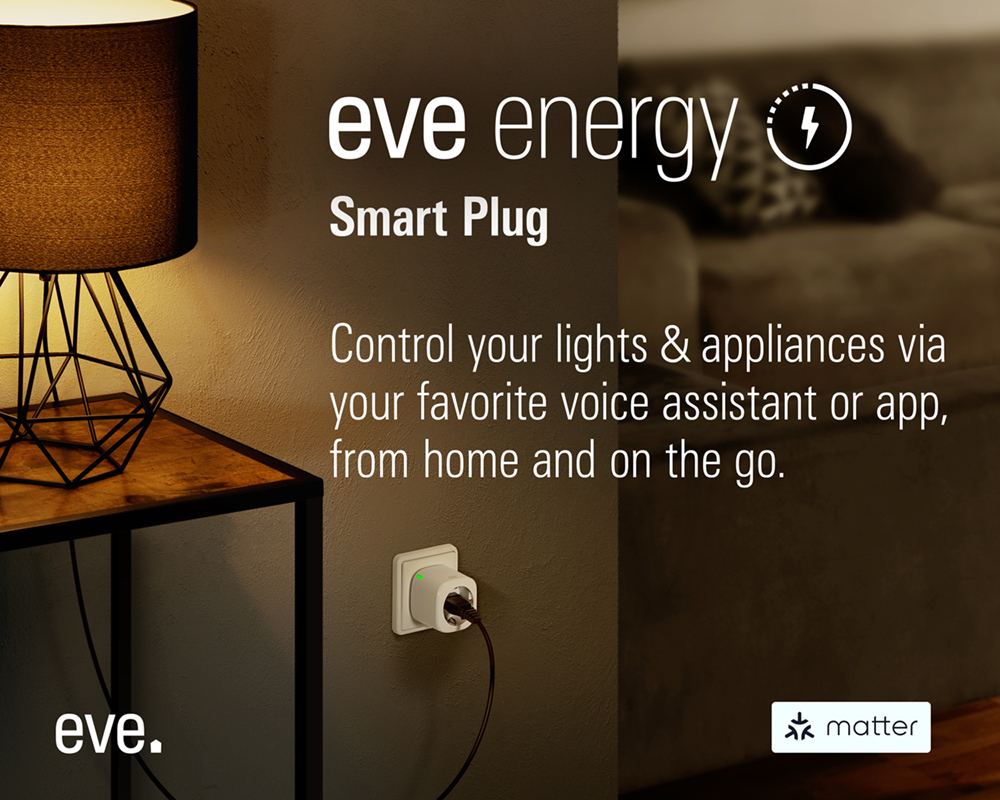Matter 1.3 is here – and packed with new functions. As the standardization organization CSA announces on its website (link), the new version has three main focuses: Energy and water management, new home appliance categories and all kinds of improvements and enhancements. When products that support Matter 1.3 come onto the market now depends on the manufacturers. They can implement the new specifications with immediate effect.
Contents
- Measure energy consumption with Matter
- Electric vehicle charging with Matter
- Water management in the Matter standard
- New household appliance categories in Matter
- Improvements in lighting with batch commands
- Matter can now also handle scenes
- Push messages with Matter Casting
- Lots to do for the big Matter platforms
Measure energy consumption with Matter
Knowing the flow of electricity in the household is becoming increasingly important – to switch devices intelligently, which saves costs and reduces the carbon footprint. Smart plugs from Ecoflow, Eve, TP-Link and other manufacturers measure energy consumption. They display these values in their app (see below) and a few compatible systems can use the data for automatic switching. Until now, providers have had to make individual adjustments for each smart home control system. Eve, for example, has collaborated with Apple and programmed drivers for SmartThings to make its energy data usable in their ecosystems.

With Matter 1.3, there is now a manufacturer-independent solution: the new version of the standard introduces energy reports. This means that every device type can transmit its measured values in real time, whether actual or estimated data. Information such as the current power, voltage and current as well as consumption or energy generation over time is therefore available to all systems that support the new feature.
Eve also plans to utilize these possibilities: “We will be mapping the extensive reporting capacities of our Eve Energy products with native Matter functionality via free firmware updates that will be released over the course of the year,” Lars Felber, Director PR at Eve Systems, explains. This means that Matter platforms apart from the two existing ecosystems will also be able to work with Eve readings.
However, the functionality is not limited to sockets. Chris LaPré, Head of Technology at the CSA: “It’s a software cluster. If the hardware is capable of it, Matter energy management can be implemented via software. This is also possible, for example, with light bulbs or other devices that have the appropriate technology.” Imagine if, in the future, all Matter appliances in the household that are connected to the power grid also provided real-time data on their consumption. The potential for energy savings would be enormous.
Electric vehicle charging with Matter
A new product category, EVSE (Electric Vehicle Supply Equipment), demonstrates the extent to which Matter ‘s energy management could also play a role in the professional sector. The term refers to chargers for electric vehicles, which appear for the first time in Matter 1.3. “We have a pretty big energy management team that is currently working on ten feature requests,” says LaPré from CSA. They’re working on things like heat pumps and solar inverters. But electric car charging systems are the first to make it into the standard.”
Wallboxes and charging stations should therefore offer a simple and user-friendly way to control the charging process. It can be started and stopped via Matter, the charging speed can be adjusted, or it can be specified how many miles of range should be “topped up” by a certain departure time. The station then ideally optimizes the process so that charging takes place at a favorable and low-CO2 time.

How and when the new option will be used remains to be seen. Especially as other components for comprehensive energy management such as heat pumps or battery storage are currently still missing and Matter is competing with other protocols such as EEBUS, OCPP and Sunspec in this area. However, the fact that the category appears in Matter at least means that there are manufacturers who are thinking about it – and would like to bring corresponding products onto the market. Otherwise, nobody would invest the time and money to participate in the CSA working groups.
Water management in the Matter standard
Version 1.3 supports leak and frost detectors, rain sensors and controllable valves, for example for garden irrigation, as a first. Extensive measures for monitoring and protecting against water damage can now be built on this. One candidate for implementation in the near future would be Eve Systems, which already has products for water management on the market. Its Eve Aqua radio-controlled irrigation valve and the Eve Water Guard Wi-Fi water sensor have not yet been certified for Matter – but would be suitable contenders.
The 2nd and 3rd generation Eve Aqua are among the Thread products, some of which have already made the leap to the new Matter firmware. However, when asked, the manufacturer does not make any promises or give timetables for the products.
New household appliance categories in Matter
Matter 1.2 brought household appliances into the standard for the first time in autumn 2023. Fridges, dishwashers, washing machines and robot vacuum cleaners can now be integrated and controlled. Although little of this has been seen so far: there have been announcements from Bosch/Siemens (BSH), Ecovacs and Roborock, and some have already been certified. However, the products are still a bit of a wait.

This does not prevent the standard from moving forward and paving the way for new household appliances. Matter 1.3 adds five product categories that – with one exception – are at home in the kitchen:
- Microwave ovens communicate their operating mode and power setting. They can send notifications when a process is complete or the food is ready. According to the CSA, Matter supports scenarios that are typical for these combinations in cross-device configurations in which the microwave is to control an extractor Hood, for example.
- Ovens are also included in Matter 1.3. The standard covers all common designs, from built-in appliances and stand-alone ovens to under-counter solutions with cooktop. If there are several compartments, each can be controlled individually, both in terms of the operating mode (standard, convection bake, roast, steam, broil/grill, proofing) and the temperature. Information on the status, such as preheating and cooling or when a desired target temperature has been reached, is also supported.
- Cooktops can be switched on remotely if the legal regulations allow this. In Germany, for example, it is not possible to start hobs remotely due to safety regulations. With ovens, the function must be confirmed with a button on the appliance before activation. If the function is available, individual elements of the cooktop can also be controlled and their current temperatures checked.
- Extractor Hoods provide access to their light settings and fan speeds. Matter 1.3 can also used to transmit status information, such as the remaining service life of an integrated air filter.
- Laundry dryers – after washing machines in version 1.2 – are now also part of the standard. Drying programs and temperatures can be selected via Matter. The appliance can send notifications at the end of the cycle or alarms in the event of errors, for example if the lint filter is blocked. If local safety regulations permit, remote start is also possible.
Improvements in lighting with batch commands
The light control options in Matter are extensive. There are so-called clusters for on/off, brightness or light colour. Until now, however, the protocol was designed more for controlling individual lamps. There was no command that could control several lights at once. The commands were sent individually, which can lead to noticeable “popcorn effects”: When switched on, the lights pop on one after the other instead of changing their operating state simultaneously.
Households with many light sources, for example on a Philips Hue Bridge, are familiar with the effect: while groups of lamps react promptly via the manufacturer’s own Hue app, control via Matter systems sometimes produces significant delays. This should improve with Matter 1.3: The new version introduces command batching, a process in which the Matter Controller combines several commands. Signify, the manufacturer of Philips Hue, plans to support the function: “With the upcoming SDK 1.3 implementation we will introduce the command batching feature that allows a Matter controller to send multiple light commands in a single Matter message. Our Bridge will translate this – where possible – into a groupcast on Zigbee, optimizing the network traffic that especially benefits bigger set-ups”, Rob Polman, Group Manager and Product Owner Hue Partnerships explains.
Matter can now also handle scenes
Another improvement is the introduction of scenes. Matter 1.3 supports setting up, reading and activating scenes at protocol level. This allows users to save the desired operating status of their devices and call it up with a command. In the example of lights, this would be brightness and color, in the case of shutters the opening status, with thermostats the temperature and so on. Matter 1.3-enabled devices can also save which scenes they belong to, which should further reduce the number of commands required for execution and improve the speed of response.
However, Matter controllers must first support the new function and save scenes that they create with their own apps in Matter on a cross-manufacturer basis. This can take time, as the example of Matter Bindings illustrates. These direct connections between Matter products have long been provided for in the standard to make installations independent of a hub during operation. However, their implementation is still a long time coming. Aqara has at least vaguely announced them for the new M3 hub.
Push messages with Matter Casting
Matter Casting, a function in the standard that is still largely under the radar, is experiencing some interesting innovations too. Currently, only Amazon uses the open protocol to stream content from its Prime Video app to its own devices such as the Echo Show 15. Others, such as the Panasonic TVs with the Fire TV operating system announced at CES 2024, are set to follow. Matter 1.3 brings various improvements to casting, for example in the search function. Among other things, it will be possible to select specific content, seasons or episodes.
However, the main new feature is messaging. Version 1.3 introduces push notifications on the TV. With the user’s consent, Matter devices can report to casting clients and transmit information. For example, the washing machine will let you know when its program is finished. Or robotic vacuum cleaners that have got stuck under the bed can call for help electronically.

A feature that will become even more important with cameras. They are currently being developed as a Matter product category, but have not made it into the current release. “Once cameras or video doorbells are there, you can find out who rang at your front door, for example,” explains Chris LaPré. “You could even have two-way communication directly on the TV,” he continues. And as with energy management, the function is not limited to one product category. It can be integrated into any type of appliance with a screen, including refrigerators with a display or control terminals that haven’t even been invented yet.
Matter casting in version 1.3 allows multi-client notifications where messages are sent to smartphone apps in the home – a function that other Matter ecosystems such as Apple Home have so far realized via their own platform. Camera streams on the TV – which already exist with HomeKit Secure Video and Apple TV – implemented there using proprietary software. It will therefore be interesting to see how the adaptation of Matter Casting progresses. There is actually an agreement among manufacturers in the Matter community that applications for which there is a solution in the standard should not be solved in a proprietary way. So things remain tense.
Lots to do for the big Matter platforms
The other new features are particularly appealing for developers. They improve the commissioning of Wi-Fi devices that support multiple frequency bands, for example. Or beaconing, which allows new devices to recognize themselves during setup via an automatically transmitted radio signal (beacon). Various clusters have been revised to optimize the code for door locks, thermostats, power sources and other things.
All this shows: The CSA and its members in the working groups are keeping up the pace to establish Matter. However, this also increases the risk of confusing consumers, as experience shows that the implementation of the standard is lagging well behind development. The major Matter platforms from Amazon to SmartThings do not even fully cover all device classes and functions from Matter 1.2 (see: “The construction sites in the Matter standard”), let alone that the products announced with it are already fully on the market. So there is still a lot to do. The good news is: things are moving forward.
Share this information:


